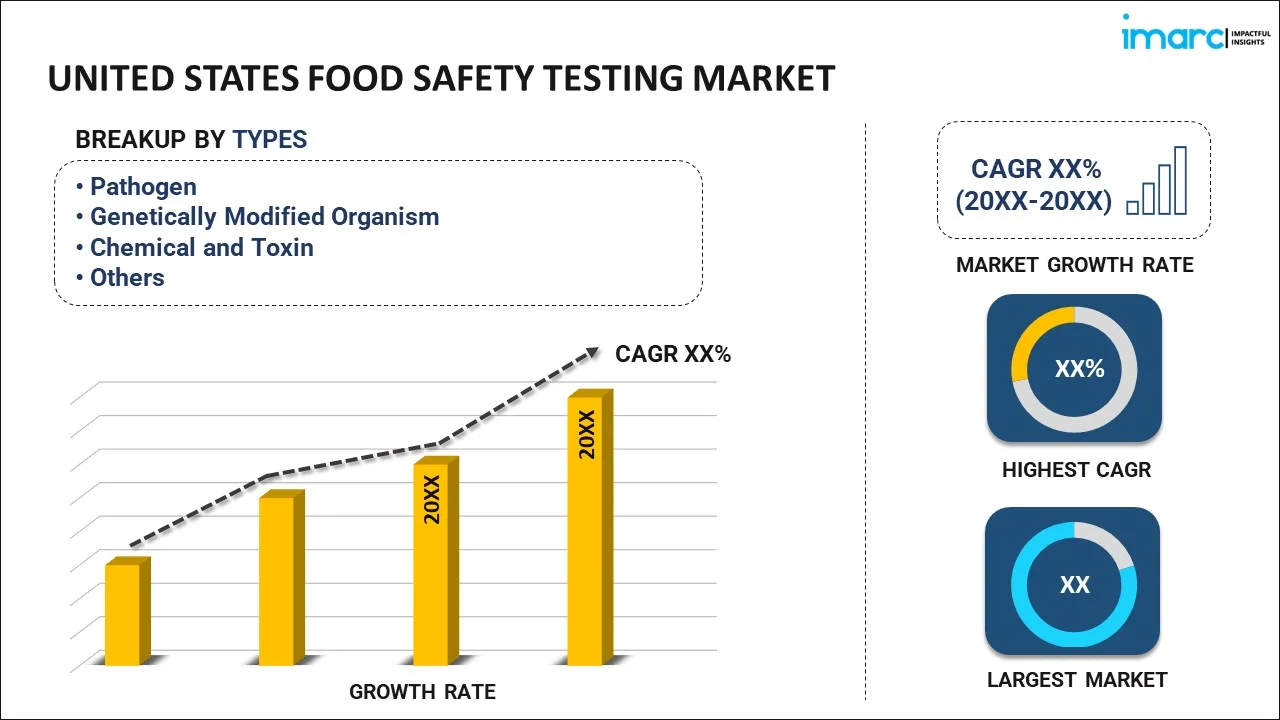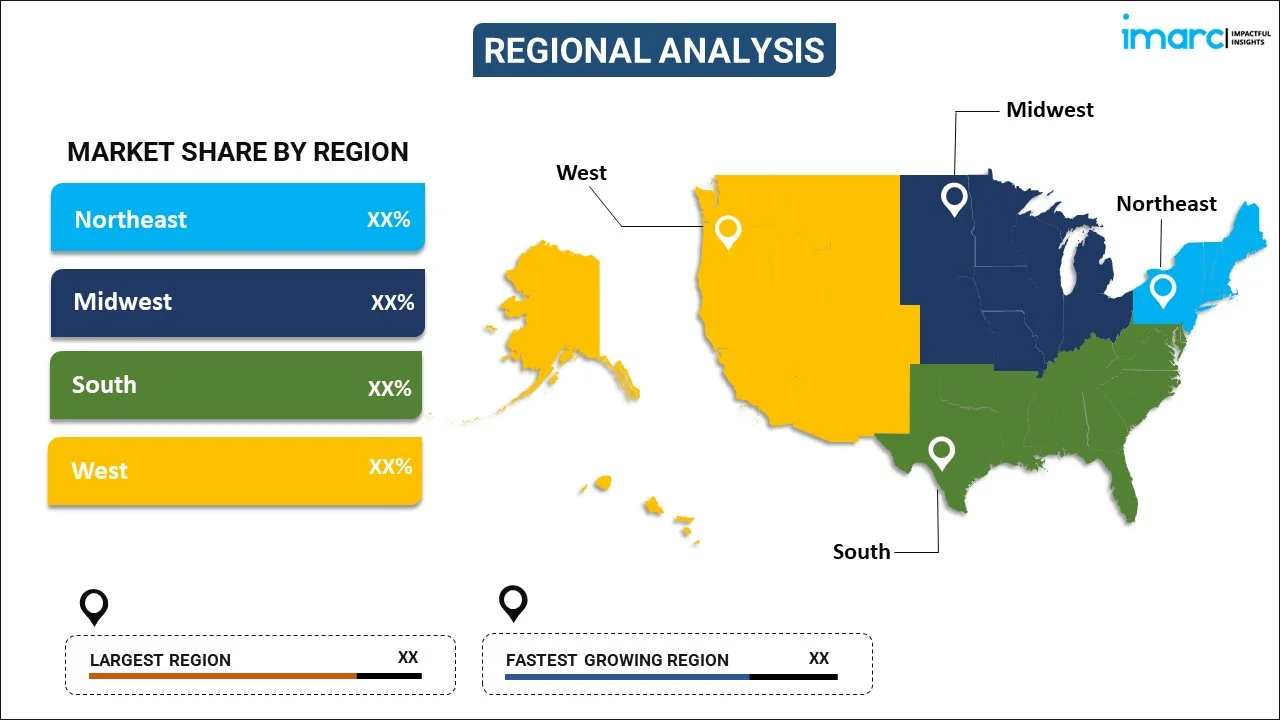
United States Food Safety Testing Market Report by Type (Pathogen, Genetically Modified Organism, Chemical and Toxin, and Others), Food Tested (Meat and Meat Products, Dairy and Dairy Products, Cereals, Grains and Pulses, Processed Food, and Others), Technology (Agar Culturing, PCR-based Assay, Immunoassay-based, and Others), and Region 2025-2033
Market Overview:
The United States food safety testing market size reached USD 6.1 Billion in 2024. Looking forward, IMARC Group expects the market to reach USD 12.3 Billion by 2033, exhibiting a growth rate (CAGR) of 8% during 2025-2033. The implementation of stringent regulatory standards, rising consumer awareness and demand for transparency in food production, the prevalence of foodborne illnesses, recent technological advancements, and the globalization of the food supply chain represent some of the key factors driving the United States food safety testing market share.
|
Report Attribute
|
Key Statistics
|
|---|---|
|
Base Year
|
2024 |
|
Forecast Years
|
2025-2033
|
|
Historical Years
|
2019-2024
|
| Market Size in 2024 | USD 6.1 Billion |
| Market Forecast in 2033 | USD 12.3 Billion |
| Market Growth Rate (2025-2033) | 8% |
United States Food Safety Testing Market Analysis:
- Key Market Trends: Adoption of rapid testing technologies, blockchain for traceability, and AI-driven diagnostics is bolstering the United States food safety testing market growth. There's growing emphasis on clean-label verification and increased outsourcing of testing services.
- Major Drivers: Stricter government regulations, rising foodborne illness outbreaks, and growing consumer demand for transparency drive market growth. Complex global supply chains also necessitate robust testing at multiple points.
- Market Opportunities: Expansion in plant-based and functional foods, rising demand for pathogen-specific testing kits, and advancements in portable testing devices offer significant growth potential for testing service providers and tech developers.
- Market Challenges: High testing costs, lack of uniform standards across states, resistance to technology adoption can also hinder widespread implementation, and limited infrastructure in small-scale food producers pose challenges in the United States food safety testing market analysis.
Food safety testing refers to an essential process employed to ensure the safety and quality of food products. It includes a series of procedures aimed at detecting potentially harmful contaminants, such as pathogens, chemicals, and genetically modified organisms (GMOs), in food. Food safety testing includes microbiological analysis, chemical and toxin analysis, allergen testing, and GMO testing. It utilizes various technologies, such as culture media, chromatography, and polymerase chain reaction (PCR). Food safety testing is employed in various sectors like meat and poultry, dairy, processed foods, fruits and vegetables, and beverages. It offers consumer protection, compliance with regulatory standards, prevention of foodborne illnesses, quality assurance, and maintenance of brand reputation. Additionally, food safety testing provides several advantages, such as improved accuracy in contamination detection, rapid testing methods, and the ability to test a wide range of contaminants.
United States Food Safety Testing Market Trends:
Stricter Regulatory Compliance and Government Oversight
The accelerating demand for processed, packed, and ready-to-consume food is another primary driver in the U.S. food safety testing market. Consumer lifestyles today promote convenience, with the result that more foods are being produced that go through multiple stages of processing, storage, and distribution—each of which provides opportunities for contamination. These foods are most susceptible to microbial contamination and chemical hazards, which require thorough safety analyses. Also, with the increasing online sales of food and delivery services, cold chain management has become more complicated, further increasing safety issues. For shelf stability and compliance with safety requirements, manufacturers have to carry out routine testing for pathogens, preservatives, toxins, and allergens. In addition, clean-label and health-conscious movements have compelled companies to make claims that are verifiable, further driving the need for authenticity and quality testing. Total growth in the consumption of processed food highlights the requirement for effective and regular food safety testing by categories.
Rising Incidence of Foodborne Illnesses
Growing incidences of foodborne illnesses within the U.S. substantially drive demand for intense food safety testing. Diseases caused by pathogens such as Salmonella, E. coli, and Listeria cause thousands of hospitalizations and fatalities each year, pushing food companies across the supply chain to take action. Notorious outbreaks have not only raised public concern but also created more liability pressures on food firms. The consumers are better educated and want transparency and accountability, forcing food producers to implement preventative testing protocols. The cost of recalls, litigation, and brand loss is also a motivator for companies to ensure food safety. Moreover, the global supply chain complexity enhances the chances of contamination, so more invasive monitoring at each point becomes necessary. Consequently, routine and trustworthy testing—especially microbial and chemical testing—became necessary to ensure food integrity, public confidence, and compliance with laws.
Growth of Packaged and Processed Food Consumption
One of the main drivers in the U.S. food safety testing market is the ever-stringent regulations imposed by government bodies such as the FDA, USDA, and EPA. The Food Safety Modernization Act (FSMA) has changed the paradigm from reaction to prevention, mandating food producers to apply hazard analysis and risk-based preventive controls. This has resulted in mandatory and regular testing of raw materials, in-process products, and finished goods for ensuring compliance. Furthermore, accuracy in labeling, pathogen control, and allergen testing is under increased scrutiny. With tightening regulatory requirements, food manufacturers have to spend on precise testing solutions to prevent recalls, penalties, or prohibition. Enhanced monitoring and traceability demands also call for effective data and sample tracking, further contributing to the need for sophisticated testing technologies like PCR, immunoassays, and chromatography. Compliance is not longer a choice—it's an integral component of brand reputation and operational viability.
United States Food Safety Testing Market Segmentation:
IMARC Group provides an analysis of the key trends in each segment of the market, along with forecasts at the country level for 2025-2033. Our report has categorized the market based on type, food tested, and technology.
Type Insights:

To get more information on this market, Request Sample
- Pathogen
- Genetically Modified Organism
- Chemical and Toxin
- Others
The report has provided a detailed breakup and analysis of the market based on the type. This includes pathogen, genetically modified organism, chemical and toxin, and others.
Food Tested Insights:
- Meat and Meat Products
- Dairy and Dairy Products
- Cereals, Grains and Pulses
- Processed Food
- Others
A detailed breakup and analysis of the market based on the food tested have also been provided in the report. This includes meat and meat products, dairy and dairy products, cereals, grains and pulses, processed food, and others.
Technology Insights:
- Agar Culturing
- PCR-based Assay
- Immunoassay-based
- Others
The report has provided a detailed breakup and analysis of the market based on the technology. This includes agar culturing, PCR-based assay, immunoassay-based, and others.
Regional Insights:

- Northeast
- Midwest
- South
- West
The report has also provided a comprehensive analysis of all the major regional markets, which include the Northeast, Midwest, South, and West.
Competitive Landscape:
The market research report has also provided a comprehensive analysis of the competitive landscape in the market. Competitive analysis such as market structure, key player positioning, top winning strategies, competitive dashboard, and company evaluation quadrant has been covered in the report. Also, detailed profiles of all major companies have been provided.
Latest News and Developments:
- In July 2025, Agriculture Secretary Brooke Rollins announced a new USDA initiative to enhance food safety, launched at the opening of the modernized Midwestern Food Safety Laboratory in St. Louis. The plan empowers FSIS to better prevent foodborne illness in meat, poultry, and egg products through enhanced collaboration with FDA and CDC, reinforcing the Trump administration’s commitment to a safer national food supply.’
- In March 2025, HHS Secretary Robert F. Kennedy, Jr. and the FDA unveiled the Chemical Contaminants Transparency Tool (CCT Tool), a searchable online database listing tolerances and action levels for harmful substances in food. Aimed at improving public health and transparency, the tool helps assess chemical risks in human foods and supports the FDA’s mission to minimize chemical hazards in the U.S. food supply.
United States Food Safety Testing Market Report Coverage:
| Report Features | Details |
|---|---|
| Base Year of the Analysis | 2024 |
| Historical Period | 2019-2024 |
| Forecast Period | 2025-2033 |
| Units | Billion USD |
| Scope of the Report | Exploration of Historical and Forecast Trends, Industry Catalysts and Challenges, Segment-Wise Historical and Predictive Market Assessment:
|
| Types Covered | Pathogen, Genetically Modified Organism, Chemical and Toxin, Others |
| Food Tested Covered | Meat and Meat Products, Dairy and Dairy Products, Cereals, Grains and Pulses, Processed Food, Others |
| Technologies Covered | Agar Culturing, PCR-based Assay, Immunoassay-based, Others |
| Regions Covered | Northeast, Midwest, South, West |
| Customization Scope | 10% Free Customization |
| Post-Sale Analyst Support | 10-12 Weeks |
| Delivery Format | PDF and Excel through Email (We can also provide the editable version of the report in PPT/Word format on special request) |
Key Benefits for Stakeholders:
- IMARC’s industry report offers a comprehensive quantitative analysis of various market segments, historical and current market trends, market forecasts, and dynamics of the United States food safety testing market from 2019-2033.
- The research report provides the latest information on the market drivers, challenges, and opportunities in the United States food safety testing market.
- Porter's five forces analysis assist stakeholders in assessing the impact of new entrants, competitive rivalry, supplier power, buyer power, and the threat of substitution. It helps stakeholders to analyze the level of competition within the United States food safety testing industry and its attractiveness.
- A competitive landscape allows stakeholders to understand their competitive environment and provides an insight into the current positions of key players in the market.
Key Questions Answered in This Report
The food safety testing market in the United States was valued at USD 6.1 Billion in 2024.
The United States food safety testing market is projected to exhibit a CAGR of 8% during 2025-2033, reaching a value of USD 12.3 Billion by 2033.
Key factors driving the United States food safety testing market include stringent regulatory requirements, rising cases of foodborne illnesses, growing consumer demand for transparency, and increased consumption of packaged and processed foods. Technological advancements in rapid testing methods also support market growth by enabling faster, more accurate detection of contaminants.
Need more help?
- Speak to our experienced analysts for insights on the current market scenarios.
- Include additional segments and countries to customize the report as per your requirement.
- Gain an unparalleled competitive advantage in your domain by understanding how to utilize the report and positively impacting your operations and revenue.
- For further assistance, please connect with our analysts.
 Request Customization
Request Customization
 Speak to an Analyst
Speak to an Analyst
 Request Brochure
Request Brochure
 Inquire Before Buying
Inquire Before Buying




.webp)




.webp)












